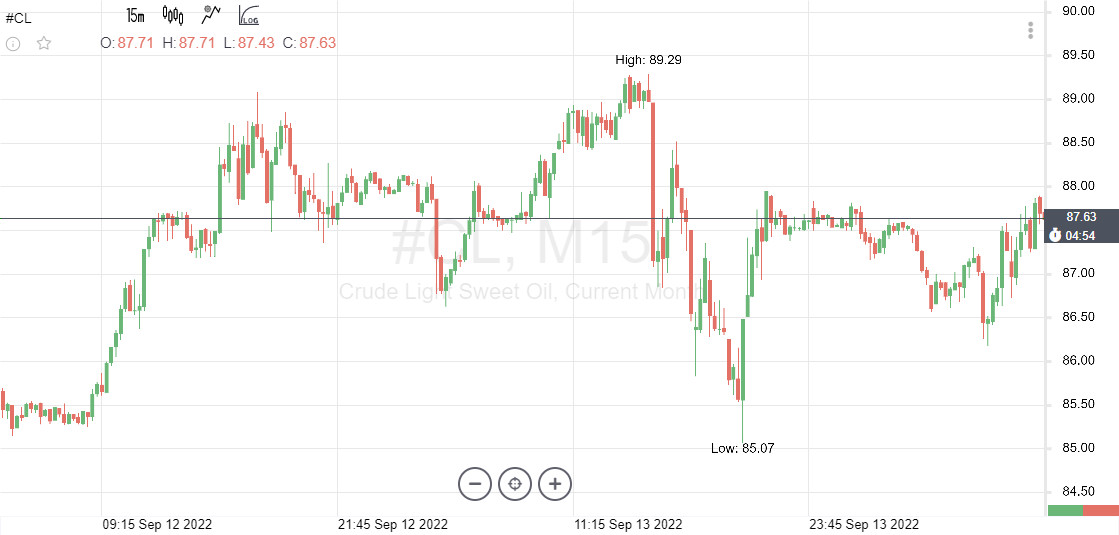
On Wednesday, oil prices were falling amid the expectations of another key interest rate hike by the Fed. The meeting is scheduled for next week. However, after the publication of the IEA's report, the quotes resumed rising.
Thus, on the London ICE Futures Exchange, Brent futures for November traded at $93.53 per barrel, which is 0.39% higher than yesterday. On Tuesday, the contracts dropped by 0.9% to $93.17.
On the New York Mercantile Exchange, WTI futures for October inched up by 0.37% to settle at $87.63 per barrel. Yesterday, the price declined by 0.5% to $87.31.

Early on Wednesday, oil prices were under significant pressure from the US inflation report. The data proved once again that a new hike in the interest rates is inevitable.
Thus, in August, the US CPI increased by 8.3% on a yearly basis compared to a rise of 8.5% in July. Inflation is slackening less than expected. The Wall Street Journal had anticipated inflation at 8%, whereas analysts at Trading Economics had forecast a decline to 8.1%.
To discuss the current economic situation and outline a future plan, Fed officials will meet next Tuesday and Wednesday.
Expectations of another considerable key interest rate hike affected markets' sentiment and significantly boosted the greenback. All these facts are exerting pressure on oil. On Tuesday, the US dollar surged by 1.5% against the euro, by 1.2% against the yen, and by 1.6% against the pound sterling.
However, earlier today, the greenback was losing value against the euro, the yen, and the British pound. The ICE index, which shows the dynamics of the US dollar against six currencies (the euro, Swiss franc, yen, Canadian dollar, pound sterling, and the Swedish krona), lost 0.33% to settle at 109.45.
What is more, today, the International Energy Agency, IEA, disclosed its report. The IEA expects large-scale switching from gas to oil, estimated to average 700,000 barrels per day in October 2022 to March 2023. These figures twice exceeded the figures recorded in the previous year. The IEA also said that global observed inventories fell by 25.6 million barrels in July.
OPEC supports the agency's views on increasing demand. According to the alliance's experts, global demand will increase this year and continue to grow next year. OPEC explains its expectations by the fact that now in most big countries, the economic situation is better than previously expected, even despite such serious obstacles as high inflation.
Meanwhile, in China, people still cannot go where they want due to the restrictions imposed amid the spread of COVID-19. Today, the most populous country in East Asia is hosting the Mid-Autumn Festival, which usually lasts three days and is traditionally marked by a surge in tourist trips within the country. However, this year, people are forced not to leave their cities and even districts. According to the Ministry of Culture and Tourism, trips in China decreased by 16.7%, tourism revenues fell by 22.8%.
China is the largest global importer of oil. However, a significant decrease in consumption led to a decline in the global demand for oil. If demand expectations worsen, oil may resume falling.
Thus, oil is still under pressure due to China's lockdowns, which limit demand, the ongoing war in Ukraine, the growing crisis in Europe, and, undoubtedly, a very expensive dollar. Although positive news supports oil prices, this is not the most significant factor. Until next week, price movements on energy and other financial markets will be mainly determined by the Fed meeting and expectations of further monetary policy tightening.
 English
English 
 Русский
Русский Bahasa Indonesia
Bahasa Indonesia Bahasa Malay
Bahasa Malay ไทย
ไทย Español
Español Deutsch
Deutsch Български
Български Français
Français Tiếng Việt
Tiếng Việt 中文
中文 বাংলা
বাংলা हिन्दी
हिन्दी Čeština
Čeština Українська
Українська Română
Română

